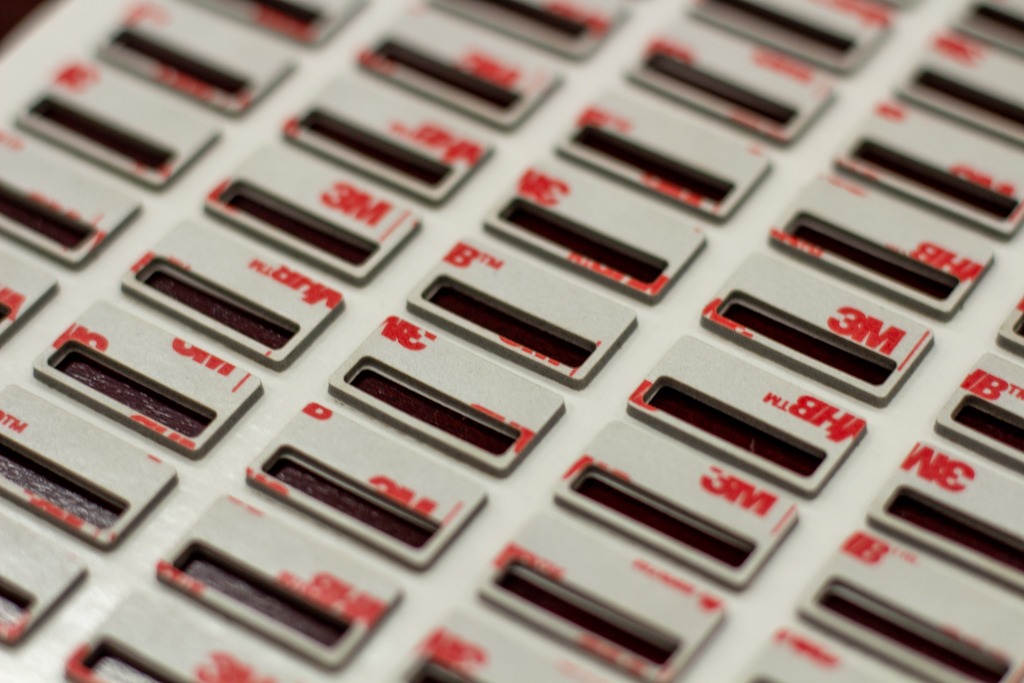
Laser Cutting Has Evolved: Here Are its Advantages Over Die-Cutting
When it comes to using 3M™ VHB™ foam tape, precision is paramount.
For decades, die-cutting was the go-to method to convert 3MTM VHB™ and other foam materials like PORON and BISCO. In terms of overall efficiency and consistent quality, die-cutting came closest to hitting these targets.
However, achieving close tolerances with thicker materials proved difficult at best.
Today, however, thanks to advances in laser-cutting technology, project designers can now achieve more intricate dimensions and even tighter tolerances from VHB™ tape and other foam materials.
That offers more freedom of design without sacrificing quality or raising the overall costs of custom gaskets.
In the following, we’ll unpack the differences between the two cutting methods. Then, we’ll discuss how laser cutting can help you achieve more intricate, precise shapes from your custom adhesive backed gaskets.
Die-Cutting vs. Laser Cutting: Understanding The Fundamentals
Which is best for cutting foam tapes: die-cutting or laser cutting?
Short answer: It depends on what’s more critical — product quality or production efficiency.
Traditional die-cutting presses the metal die into the material to cut out the desired shapes. A custom die results in higher upfront costs and increases lead time initially. Overall, die cutting often produces the highest volume of identical shapes in the least amount of time at a relatively low cost per unit.
However, if intricate shapes and very close tolerances are top priority, laser cutting may be the better option.
Laser cutting uses a high-powered beam of heat guided by computer software to cut materials with exceptional precision. Because there is no need for dies, laser cutting was always a great option for prototyping and small batch production runs.
Recent advances in laser cutting have made it faster and more precis, making it a more viable option even for thicker foam materials like VHB™ Tape.
Greater precision in thick foam materials
One of the most compelling advantages of laser cutting over die-cutting is its ability to cut very close tolerance parts from thicker foam materials like VHB™ tape. Here’s a comparison of their tolerance ranges:
- Die-cutting +/- .030 inches
- Laser cutting: +/- .005 inches
That’s a 6x improvement in dimensional accuracy — a major advantage for applications requiring tight part fits or clean edge finishes.
With this level of precision, laser cutting opens new possibilities for product design. Would you like to achieve complex geometries or more intricate features? Despite the relative thickness of VHB™ tape, these are easily achieved with laser cutting.
Greater material efficiency through nesting
Another advantage of laser cutting is it can also slash material use, thanks to the use of computer-aided technology.
Die-cutting can leave behind more matrix because of the nature of the manufacturing process. Sufficient space must be left for material displacement as the metal die slices through the material.
However, laser-cutting’s precision and its computing capabilities can nest parts closely together. The result is more parts per yard and a significant reduction in material waste. You’ll reduce material costs while also being a little gentler on the environment.
Faster prototypes and design flexibility
A key advantage of laser cutting is it offers greater range of design flexibility than traditional metal dies.
The beam is guided by computer software, meaning all that’s needed is a CAD file to start production. Any last-minute design changes can be adapted immediately. Because laser cutting requires no custom tooling, it’s well-suited for quick-turn prototyping and rush orders.
Kiss-cutting for easier assembly
Another technological advancement of laser cutting is it can also perform kiss cuts — a technique where the laser cuts through the top layer of material and adhesive, but keeps the liner intact.
This is ideal for applications where parts need to be easily handled and assembled, reducing the risk of damaging the adhesive during handling.
Best Materials for Laser Cutting (Gaskets, Seals & Pads)
Foam Materials
Laser cutting can cut precision shapes from foams, especially for complex geometries and tight tolerances.
- 3M™ VHB™ Tape (Acrylic Foam Core)
- PORON® Polyurethane
- BISCO® Silicone Foams
- EPDM Closed-Cell Foam
- Neoprene Sponge (Closed-Cell)
Adhesive-Backed Materials
Laser cutting is ideal for kiss-cutting and precision layering.
- 3M™ Adhesive Transfer Tapes
- 3M™ Double-Sided Tapes
- Foam tapes with liners
Miscellaneous Specialty Materials
Laser cutting can also be applied to certain engineered materials:
- EMI Shielding Foils (with adhesives)
- Thermal Interface Materials (TIMs)
Unlock New Design Potential With Laser Cutting
At SRP, we’re fully equipped to help you innovate. When it comes to high-performance gaskets and seals, our solutions will raise your standards in design and function.
Send us your CAD file through our online form and we’ll get you a fast, accurate quote.
